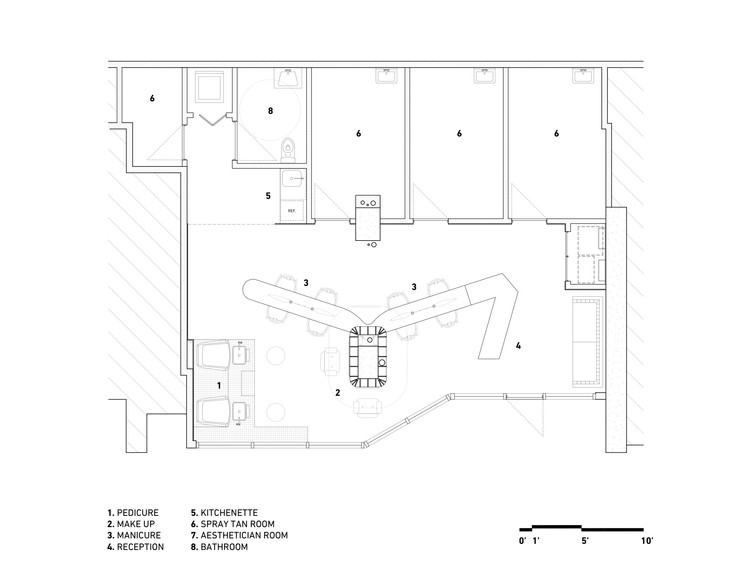Moore Park Residence Drew Mandel Architects
2014-10-05 01:00
© Ben Rahn / A-Frame
C.Ben Rahn/A-框架


架构师提供的文本描述。这座充满水的房子位于多伦多市中心摩尔公园的住宅区.它代表了在一条公认的街道上的第一次拆迁,这条街道的特征是一种共同的模式:20世纪20年代有着共同动力的单身家庭住宅。该项目的概念是将重新设想的单一家庭住宅整合到一个典型的多伦多街景中。
Text description provided by the architects. This infill house is situated in the mid-town Toronto residential neighborhood of Moore Park. It represents the first tear-down replacement on an established street that is characterized by a common model: 1920s-era single-family homes with mutual drives. The concept of the project is to integrate a re-imagined single-family residence into a typical Toronto streetscape.


该设计包括标志性的,房子式的现有街景,并加强挫折,材料和与等级的关系。然而,它提出了一个当代的家的例子。三楼位于前、后两层,与街道上现有的聚集点相匹配,同时为东侧和西侧的绿色屋顶露台和隐私提供了机会。
The design embraces the iconic, house-like forms of the existing streetscape and reinforces the setbacks, materials, and relationship with grade. However, it puts forward a contemporary example of home. The third floor is set back at the front and rear and match existing massing on the street, while providing opportunities for green roof terraces and privacy at the east and west side.
© Ben Rahn / A-Frame
C.Ben Rahn/A-框架


这所房子形成了复杂的人格化关系.它是由光和阴影动画,它是由一个板构成的混凝土墙,透明隔墙,相互连接的空隙,和一个大的光井,切分三层楼。混凝土墙满足建筑规范对南方无保护开口的限制,同时允许光线深入地下室。
The house forms a complex figure-ground relationship. It is animated by light and shadow, and it is structured by a board-formed concrete wall, transparent partitions, interconnecting void spaces, and a large light well that slices through three storeys. The concrete wall satisfies building code restrictions on unprotected openings to the south while allowing light to reach deeply into the basement.
© Ben Rahn / A-Frame
C.Ben Rahn/A-框架


最低层在后方地面平面下面滑动,在那里你可以进入一个狭小的外部空间,从上面对光线开放。楼层和空间在视觉上是相互联系的,但却被定义为现代家庭生活的各种活动。这是半开放的房子;一个精致的玻璃信封外壳。
The lowest storey slides underneath the rear ground plane where one can access a narrow exterior space that is open to light from above. The floors and spaces are visually interconnected yet defined for the varied activities of modern family living. It is the half-open house; a nuanced glass envelope enclosure.
© Ben Rahn / A-Frame
C.Ben Rahn/A-框架


这座房子的设计是为了适应家庭在不同场合和一生中不断变化的需求和兴趣。后面的“泥房”、厨房、餐厅和前面的入口空间都会流进它们相邻的空间,以便适应住宿。这些空间有着广泛的用途:一楼的磨坊细节可以为大型家庭聚会提供一张扩展的桌子;在整个房子里找到的四个办公桌区域允许各种家庭办公的选择;地下室被视为一个优质的空间,而不是次要的空间,以便最大限度地利用现有的空间。
The house is designed to accommodate a family’s changing needs and interests in different occasions and through its lifetime. The rear ‘mud room’, kitchen, dining and front entry spaces all bleed into their adjacent space for adaptive accommodation. The spaces have a range of uses: The ground floor millwork detailing allows an extended table for large family gatherings; four desk areas found throughout the house allow for a variety of home-office options; the basement is treated as a prime, and not a secondary space in order to maximize the use of available space.


景观美化把房子的经验扩展到现场。它包括一个煤气火灾坑,一个邮递员弯曲的脚径,以及三个独立的居住绿色屋顶区域。三楼露台提供了令人愉快的意见,成熟的树冠周围的邻里。三楼主套房的形状天花板是不间断的,以保持景观和进入自然光。
The landscaping extends the experience of the house into the site. It includes a gas fire pit, curved foot path for a mailman, and three separate areas of living green roofs. The third floor terraces offer delightful views of the mature tree canopy surrounding the neighbourhood. The shaped ceiling of the third floor master suite is uninterrupted in order to maintain both the views and access to natural light.
© Ben Rahn / A-Frame
C.Ben Rahn/A-框架








































Architects Drew Mandel Architects
Location Toronto, Canada
Category Houses
Design Team Drew Mandel, Jowenne Poon, Rachel Tameirao, Jasmine Maggs
Area 2880.0 ft2
Project Year 2014
Photographs Ben Rahn / A-Frame
























